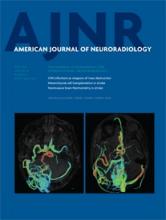Abstract
BACKGROUND AND PURPOSE: Applications for noninvasive biologic temperature monitoring are widespread in biomedicine and of particular interest in the context of brain temperature regulation, where traditionally costly and invasive monitoring schemes limit their applicability in many settings. Brain thermal regulation, therefore, remains controversial, motivating the development of noninvasive approaches such as temperature-sensitive nuclear MR phenomena. The purpose of this work was to compare the utility of competing approaches to MR thermometry by using proton resonance frequency chemical shift. We tested 3 methodologies, hypothesizing the feasibility of a fast and accurate approach to chemical shift thermometry, in a phantom study at 3T.
MATERIALS AND METHODS: A conventional, paired approach (difference [DIFF]-1), an accelerated single-scan approach (DIFF-2), and a new, further accelerated strategy (DIFF-3) were tested. Phantom temperatures were modulated during real-time fiber optic temperature monitoring, with MR thermometry derived simultaneously from temperature-sensitive changes in the water proton chemical shift (∼0.01 ppm/°C). MR thermometry was subsequently performed in a series of in vivo nonhuman primate experiments under physiologic and ischemic conditions, testing its reproducibility and overall performance.
RESULTS: Chemical shift thermometry demonstrated excellent agreement with phantom temperatures for all 3 approaches (DIFF-1: linear regression R2 = 0.994; P < .001; acquisition time = 4 minutes 40 seconds; DIFF-2: R2 = 0.996; P < .001; acquisition time = 4 minutes; DIFF-3: R2 = 0.998; P < .001; acquisition time = 40 seconds).
CONCLUSIONS: These findings confirm the comparability in performance of 3 competing approaches to MR thermometry and present in vivo applications under physiologic and ischemic conditions in a primate stroke model.
ABBREVIATIONS:
- DIFF
- difference
- PRF
- proton resonance frequencies
- © 2015 by American Journal of Neuroradiology
Indicates open access to non-subscribers at www.ajnr.org












